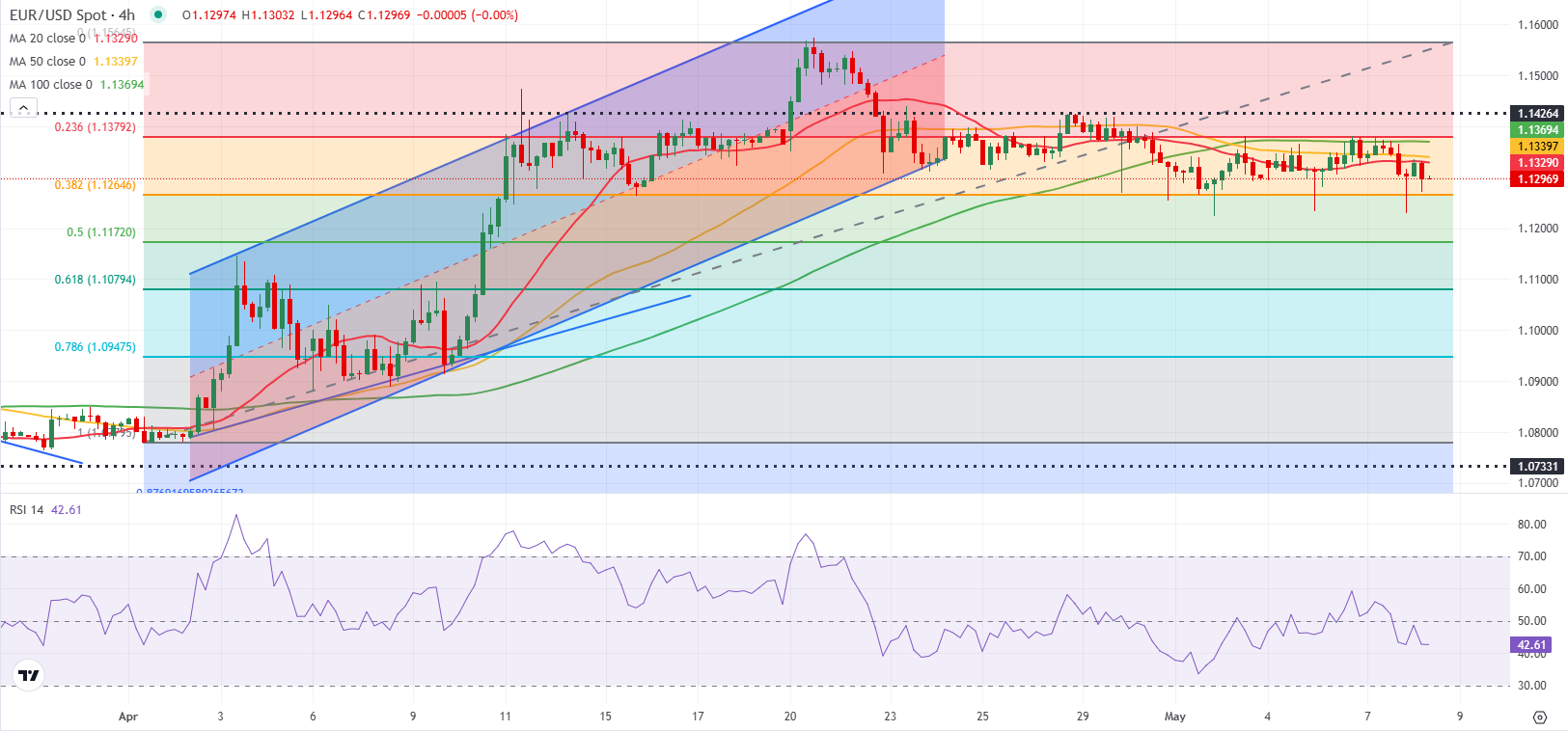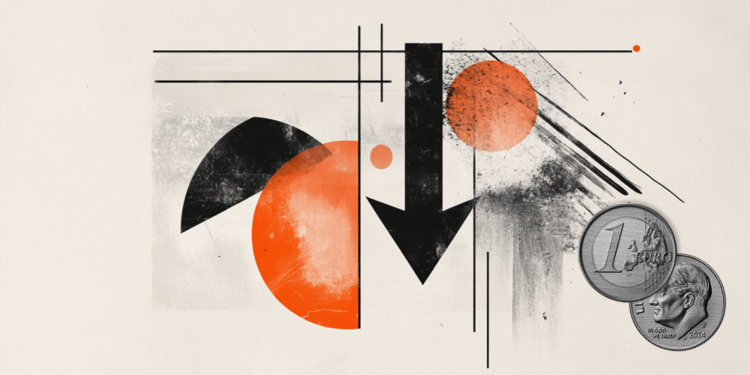- EUR/USD struggles to stabilize above 1.1300 after closing in the red on Wednesday.
- Technical sellers could take action in case the pair breaks below 1.1270.
- Markets see a diminishing chance of a Fed rate cut in June.
EUR/USD came under bearish pressure in the American session on Wednesday and closed the day deep in negative territory. The pair stays on the back foot early Thursday and trades slightly below 1.1300.
Euro PRICE This week
The table below shows the percentage change of Euro (EUR) against listed major currencies this week. Euro was the weakest against the US Dollar.
| USD | EUR | GBP | JPY | CAD | AUD | NZD | CHF | |
|---|---|---|---|---|---|---|---|---|
| USD | 0.35% | -0.18% | -0.17% | 0.45% | 0.53% | 0.37% | 0.17% | |
| EUR | -0.35% | -0.25% | -0.26% | 0.36% | 0.44% | 0.29% | 0.08% | |
| GBP | 0.18% | 0.25% | -0.21% | 0.62% | 0.70% | 0.54% | 0.33% | |
| JPY | 0.17% | 0.26% | 0.21% | 0.61% | 0.70% | 0.62% | 0.44% | |
| CAD | -0.45% | -0.36% | -0.62% | -0.61% | -0.21% | -0.08% | -0.28% | |
| AUD | -0.53% | -0.44% | -0.70% | -0.70% | 0.21% | -0.16% | -0.36% | |
| NZD | -0.37% | -0.29% | -0.54% | -0.62% | 0.08% | 0.16% | -0.21% | |
| CHF | -0.17% | -0.08% | -0.33% | -0.44% | 0.28% | 0.36% | 0.21% |
The heat map shows percentage changes of major currencies against each other. The base currency is picked from the left column, while the quote currency is picked from the top row. For example, if you pick the Euro from the left column and move along the horizontal line to the US Dollar, the percentage change displayed in the box will represent EUR (base)/USD (quote).
The Federal Reserve (Fed) announced on Wednesday that it left the policy rate, federal funds rate, unchanged at the range of 4.25%-4.5% following the May meeting, as widely anticipated. In the policy statement, the US central bank acknowledged that the uncertainty surrounding the economic outlook has increased further.
While speaking during the post-meeting press conference, Fed Chairman Jerome Powell noted that near-term inflation expectations have moved up because of tariffs and reiterated that they need to wait before adjusting the policy. According to the CME FedWatch Tool, the probability of a 25 basis points (bps) rate cut in June dropped to 20% from about 30% before the Fed event. As a result, the US Dollar (USD) gathered strength against its rivals in the American session, causing EUR/USD to push lower.
The US economic calendar will feature the weekly Initial Jobless Claims data on Thursday. Additionally, the Bureau of Labor Statistics will publish preliminary Unit Labor Costs data for the first quarter. In case there is a noticeable decline in the number of first-time applications for unemployment benefits, with a reading near 200,000, the USD could continue to outperform its rivals. On the other hand, a print above 250,000 could have the opposite impact on the currency’s valuation. Nevertheless, investors could refrain from betting on a significant weakening of the USD following the hawkish Fed event.
EUR/USD Technical Analysis

The Relative Strength Index (RSI) indicator on the 4-hour chart stays below 50 and EUR/USD closed the last four 4-hour candles below the 100-period, 50-period and 20-period Simple Moving Averages (SMA), highlighting a bearish tilt in the near-term outlook.
On the downside, 1.1270 (Fibonacci 38.2% retracement of the latest uptrend) aligns as immediate support before 1.1175 (Fibonacci 50% retracement) and 1.1080 (Fibonacci 61.8% retracement). Looking north, resistances could be spotted at 1.1380 (100-period SMA, Fibonacci 23.6% retracement, 1.1430 (static level) and 1.1500 (static level, round level).
Euro FAQs
The Euro is the currency for the 19 European Union countries that belong to the Eurozone. It is the second most heavily traded currency in the world behind the US Dollar. In 2022, it accounted for 31% of all foreign exchange transactions, with an average daily turnover of over $2.2 trillion a day.
EUR/USD is the most heavily traded currency pair in the world, accounting for an estimated 30% off all transactions, followed by EUR/JPY (4%), EUR/GBP (3%) and EUR/AUD (2%).
The European Central Bank (ECB) in Frankfurt, Germany, is the reserve bank for the Eurozone. The ECB sets interest rates and manages monetary policy.
The ECB’s primary mandate is to maintain price stability, which means either controlling inflation or stimulating growth. Its primary tool is the raising or lowering of interest rates. Relatively high interest rates – or the expectation of higher rates – will usually benefit the Euro and vice versa.
The ECB Governing Council makes monetary policy decisions at meetings held eight times a year. Decisions are made by heads of the Eurozone national banks and six permanent members, including the President of the ECB, Christine Lagarde.
Eurozone inflation data, measured by the Harmonized Index of Consumer Prices (HICP), is an important econometric for the Euro. If inflation rises more than expected, especially if above the ECB’s 2% target, it obliges the ECB to raise interest rates to bring it back under control.
Relatively high interest rates compared to its counterparts will usually benefit the Euro, as it makes the region more attractive as a place for global investors to park their money.
Data releases gauge the health of the economy and can impact on the Euro. Indicators such as GDP, Manufacturing and Services PMIs, employment, and consumer sentiment surveys can all influence the direction of the single currency.
A strong economy is good for the Euro. Not only does it attract more foreign investment but it may encourage the ECB to put up interest rates, which will directly strengthen the Euro. Otherwise, if economic data is weak, the Euro is likely to fall.
Economic data for the four largest economies in the euro area (Germany, France, Italy and Spain) are especially significant, as they account for 75% of the Eurozone’s economy.
Another significant data release for the Euro is the Trade Balance. This indicator measures the difference between what a country earns from its exports and what it spends on imports over a given period.
If a country produces highly sought after exports then its currency will gain in value purely from the extra demand created from foreign buyers seeking to purchase these goods. Therefore, a positive net Trade Balance strengthens a currency and vice versa for a negative balance.


